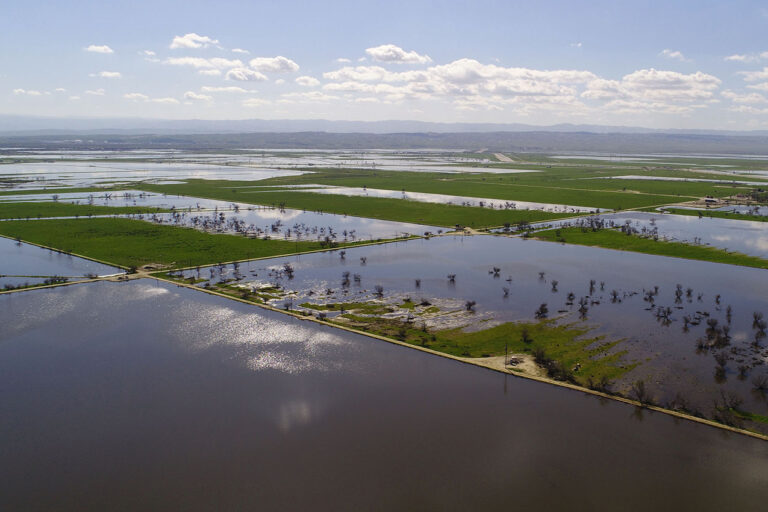
Due to a trifecta of geology, conveyance and institutional incentives, California’s most successful groundwater banks are in Kern County, where water is stored for California’s largest urban agencies as well as for farms. The practice can and should be replicated elsewhere. (Photo PPIC)
Restoring Hetch Hetchy Valley in Yosemite National Park means replacing the water storage function that Hetch Hetchy Reservoir currently provides. As we’ve shown, repeatedly and most recently in Yosemite’s Opportunity: Options For Replacing Hetch Hetchy Reservoir, it’s very doable. The challenge is institutional and lack of political will.
Groundwater recharge is the best and most cost-effective option for extending limited water supplies in semi-arid California. Broad scale recharge programs should be pursued and implemented (independent of whether people support restoring Hetch Hetchy Valley in Yosemite National Park).
Over the past three weeks, a series of storms drenched California and buried the Sierra Nevada deep in snow. Water levels in our large reservoirs have risen dramatically. Some reservoirs have maxed out already. Even if the rest of the winter is dry, the largest Sierra reservoirs will fill when the snow melts – ideally not until well into June.
Storm-driven flows have been pouring into the Pacific Ocean, disappointing many who would like to capture more water for use in cities and on farms – especially if another drought is on the horizon. A bipartisan group of lawmakers protested the “first flush” policy which limits pumping water from the Sacramento-San Joaquin Delta during the first storm of the year in order to protect endangered fisheries.
Others are frustrated that no progress has been made building the proposed Sites Reservoir, eight years after State voters authorized billions in matching funds. (California’s best dam sites were developed between 1940 and 1980; building more dams is possible but the increased costs and lower yields of more remote locations make most locations infeasible, even without considering environmental concerns.
Recharging groundwater is generally the most cost-effective way to increase water supplies, an approach highlighted by recent media coverage. It is time we learn our lesson and take corrective action.
Most of us are aware that there is far more water underground in aquifers than in surface reservoirs, although we have been “mining” that groundwater for more than a century. Groundwater levels have dropped severely in many areas. The 2014 Sustainable Groundwater Management Act (SGMA) requires limited pumping over time and will preserve California agriculture into the 22nd century at significant cost in the near term. SGMA, however, does far too little to encourage aquifer recharge when surface water is abundant.
The New York Times “Daily” podcast explains that we have channelized many of our rivers to flow narrowly between levees, eliminating natural floodplains, to build houses or manage farmland – and suggests that the floodplains should be recreated. The idea of creating such “levee setbacks” to enlarge floodplains has been around for a while – beyond replenishing groundwater, the practice provides habitat for fish and wildlife. In many cases the land can still be farmed in summer – as seen by motorists who cross the Yolo Bypass between Davis and Sacramento. There are some good opportunities for recreating floodplains, but, at the statewide level, setting back levees requires relocating entire communities and is infeasible.
It’s more useful to install infrastructure to enhance recharge – a practice recently evaluated by 200 experts as part of a State-funded Flood MAR (Managed Aquifer Recharge) investigation. (Yes, California may have a shortage of water but there is no shortage of water “experts”.) Enhanced recharge usually means directing water to dedicated spreading basins but often flows can simply flood fields where crops are grown later in the year. With the right geology, water will quickly filter into the ground. Sometimes the water is injected; there are pumps, colloquially called “switch-hitters”, which can be used both to extract and recharge groundwater.
Groundwater recharge is much more cost-effective than building reservoirs or recycling wastewater. The engineers know how to do it, but the practice is beset by institutional and even legal challenges.
It took decades for East Bay MUD (serving Oakland, Berkeley etc.) to initiate a small cooperative pilot program banking groundwater with skeptical irrigation districts in San Joaquin County. East Bay MUD provides the money and water in wet years – in dry years, they get some, but not all, of the water back.
As we have written in Yosemite’s Opportunity, there is substantial opportunity in eastern Stanislaus County to recharge and manage groundwater that could benefit to San Francisco – AND replace the storage function of Hetch Hetchy Reservoir. Installing the infrastructure and establishing a program requires cooperation of multiple agencies and a bevy of landowners.
A plethora of recent press, including a recent Op Ed by Stanford’s Dick Luthy provocatively titled Rain finally came to California. We blew our chance to use it, has been helpful. Elected leaders and water agency mangers are paying attention now, bur real progress will require significant follow-through.
Will cities and irrigation districts learn the value of working together? Do we need legislation to build on the Sustainable Groundwater Management Act to prioritize recharge?
Getting groundwater recharge right can extend water supplies in California at lowest cost and should be one of California’s top priorities.
